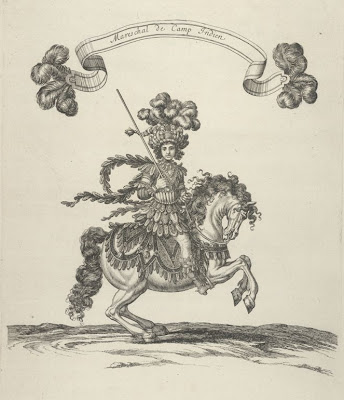


















[click for full size versions; mouseover for titles]
Prior to the royal court moving to Versailles, a festival was held by Louis XIV at Tuileries Palace in Paris in 1662 as a way of celebrating the birth of his son, Louis, le Grande Dauphin, the previous year.
After a procession past monuments in the streets of Paris the entourage entered the arena at (or adjacent to) the palace, which held 15,000 spectators. There followed an equestrian pageant {this book has an informal name of 'Circius Regius' or Royal Circus} in which the participants from the upper echelons of society and the Court were divided into groups, representing the 5 great nations: Romans, Moors (Indians), Turks, Persians and American Indians.
In the style of a medieval tournament the horsemen engaged in equestrian tests such as jousting through rings, and racing. The riders were all decked out in the finest jewel-encrusted silk brocade, streamers, feathered headwear and wigs with some of the saddles said to be covered by leopard and tiger skins. Although this is self-evident from the engravings perhaps, these kind of details are confirmed by eyewitness accounts, so the illustrators weren't always exaggerating.
The engravings, in a dramatic baroque style, were produced by François Chauveau and Sylvain Sylvestre. If you only enlarge one of the above images, look at the first one - the embellished grooming is fantastic, in all senses of the word. Such stylistic elements no doubt contributed to the book's popular reception when it was published in 1670. [As best as I understand it, there were no actual Americans or Turks etc in the parade - it was all a theatrical piece played out by Dukes, Princes and similar Lordly types, including Louis XIV himself who was unsurprisingly the Roman King]
The accompanying text was written by (the later) renowned fairytale writer, Charles Perrault {previously}, who was brother to the favoured architect of the Court at the time, Claude Perrault {previously}, designer of some major additions to Le Louvre.
- Illustrated samples from 'Courses de Testes et de Bague Faittes par le Roy et par les Princes et Seigneurs de sa Cour en l'Année 1662' are online among the festival books at the British Library.
- The complete work - photocopy quality - is available from BNF.
- This pdf catalogue (3Mb) has a couple of pages (in french) describing the book from an exhibition in Versailles in 2003 (about p.27).
No comments:
Post a Comment